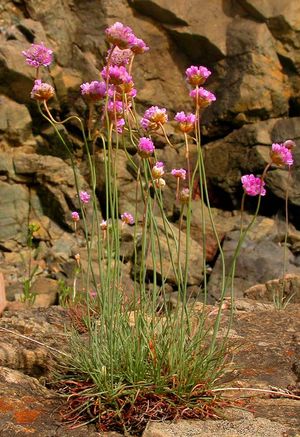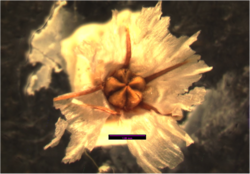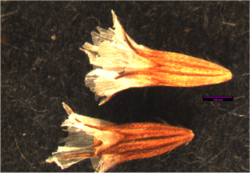Armeria maritima
- Latin Name: Armeria maritima
- Family: Plumbaginaceae
- Common Names: sea-pink, thrift
- Codon: ARMMAR
Contents
Taxonomy
| Armeria maritima | |
|---|---|

| |
| Photo by Ben Legler, 2004. Also featured on Main Page | |
| Scientific classification | |
| Kingdom: | Plantae |
| Subkingdom: | Viridiplantae |
| Phylum: | Tracheophyta |
| Subphylum: | Spermatophytina |
| Class: | Magnoliopsida |
| Subclass: | Caryophyllanae |
| Order: | Caryophyllales |
| Family: | Plumbaginaceae |
| Genus: | Armeria Willd. |
| Species: | Armeria maritima (Mill.) Willd. |
Description
This plant forms dense tussocks of grayish-green, linear leaves and pubescent flower stems. Up to 12 in. tall, the flower stems terminate in a small, round head of pink to lavender flowers. A low plant with a basal cluster of many narrow leaves and, atop a slender, leafless stalk, a globe of pale lilac flowers, beneath which are several broad, purplish, papery bracts. Tussocks of dried leaves are persistent. It resembles a small onion, but the two families are only related in that they are flowering plants.[1]
Bloom Period
March - July[2]
Distribution
Alaska to California, across Canada. Also Greenland and Europe.[2]
Habitat
Ecological Setting-Gravelly tundra, along beaches and coastal bluffs, occasionally inland. Soil Texture-Medium to coarse, moist to dry, well drained soils Soil Reaction / Salinity-4.7-7.5 pH – low salinity tolerance Moisture Regime Medium moisture use – low drought tolerance Shade Tolerance No tolerance Successional Status-Early
Uses
Wildlife-Attracts bees, low palatability for browsing and grazing animals like deer. The flowers attract painted lady butterflies. The mat-like vegetation provides shelter for many invertebrates such as the slug-eating ground beetle. Landscaping-Commercially available First Nations-n/a Other-High C:N ratio
Propagation
Fruit and Seed Collection-Collect A. maritima v. californica when seeds are tan and the papery husk has no green coloration. Flick off the seed with the husk attached. Seed Storage-Due to lack of information on temperature and humidity requirements on A. maritima v. californica as well as information on yearly loss of viability, the A. maritima v. californica is kept at a standard storage of 40f and 40% humidity. Fruit/Seed Dormancy and Treatment-Seeds do not need pre-treatment
Seed
Seed sample from: 2011
Average Measurement: 4.9 x 1.2 x 1.2Measurement Range: L: 4.3 – 5.5, W: 1 – 1.5, D: 1.1 – 1.4
Features
Shape: Seeds narrow at hilum, widening at opposite apex to form a tube shaped opening with five ribs flaring out from the end of the seed. Inside tube structure is five lobed star shaped structure.
Color: Ribs brown, connected with a white transparent membrane. Star shaped structure is tan.
Surface: Seed is longitudinally ribbed, and has a slight sheen.
Latitudinal Cross Section: elliptical
Longitudinal Cross Section: obovate ![]()
Basic Explanations and Assumptions:
The dimensions for the seeds are length x width x depth. The location of the hilum is used as the base of the seed, and the length is measured from hilum to the opposite apex. Where a style is present, the length is measured from the hilum to the bottom of the style. Width is measured at a right angle to the length at the widest part. Depth is measured at a right angle to the intersection of height and width lines.
Measurements included are the mean average for each measurement of ten separate seeds.
All measurements in millimeters unless otherwise noted.
Photo Gallery
References
- ↑ Native Plants of North America. Retrieved from https://www.wildflower.org/plants/result.php?id_plant=arma6
- ↑ 2.0 2.1 WTU Herbarium, Burke Museum, & University of Washington. Retrieved from http://biology.burke.washington.edu/herbarium/imagecollection/taxon.php?Taxon=Armeria%20maritima



